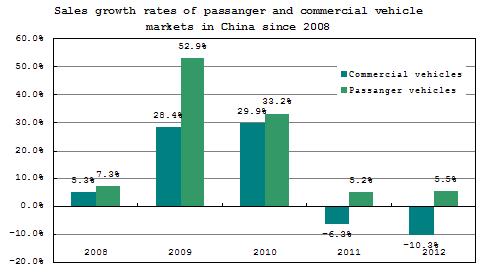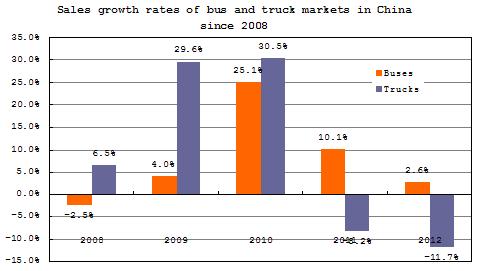Summary: Sales growth rates in the commercial vehicle market from 2008 onwards
In an effort to stimulate growth in the commercial automobile market, China introduced a new set of policies earlier this month offering subsidies for owners buying new vehicles to replace their old ones. As the state of the commercial vehicle market is intricately tied to the status of the economy overall, it is more easily affected by macroeconomic changes than the passenger automobile market.
Ever since 2008, growth in the commercial vehicle market has been lagging behind that of passenger vehicles. In 2008, when the global financial crisis was in full swing, the commercial vehicle market grew only 5.3 percent, while the passenger vehicle market increased by 7.3 percent. Both growth rates were lower than anticipated.
In response to this, the government introduced a slew of new policies to encourage market growth in late 2008. The government put aside four billion yuan ($584.86b) to implement the policies, which included new 'old for new' and 'down to the countryside' subsidies. In 2009, growth rates in both the commercial and passenger vehicle markets increased to 28.4 percent and 52.9 percent, respectively. Growth in the former increased another 1.5 percent the following year.

However, several of the stimulatory policies were phased out by 2011. The effects on the automobile market, especially the commercial vehicle market, were quite noticeable. A total of 4.03 million commercial vehicles were sold that year, 6.3 percent less than 2010.
The growth rate is continuing to decline into this year. According to recent statistics, a total of 1.69 million commercial vehicles have been sold from January to May, 10.3 percent than the amount sold during the same period of time last year. By comparison, the passenger vehicle market has maintained positive growth of 5.5 percent.
When further analyzing growth among individual segments in the market, some interesting discoveries are to be made. In 2008, due to rising resource prices, the occurrence of several natural disasters and other factors, bus sales fell 2.5 percent from the previous year. The market for trucks, meanwhile, maintained slight positive growth.
The effect from the four trillion yuan in subsidies the following year was most apparent in the truck market, which grew 29.6 percent in 2009 and 30.5 percent in 2010. The bus market, meanwhile, finally saw positive growth in 2009, increasing four percent. The growth rate shot up to 25.1 percent the next year. The increase was attributed to continuing investment and growing trade.

A real shift occurred last year, when overall growth in the automobile market began to falter. Although truck sales fell 8.2 percent, growth in bus sales managed to remain positive. That trend is continuing into this year, where the sales growth rate from January to May for buses was a positive 2.6 percent, compared to a negative 11.7 percent for trucks. 191,700 buses have been sold in the first five months of the year.
Related Article
- Tireworld Insight: Domestic tire makers eye overseas expansion
- Tireworld Insight: Price disparity severe between China's rubber exports and imports
- Tireworld Insight: China tire exports dependent on US market performance
- Tireworld Insight: SHFE rubber expected to move in tight range in short-term
- Tireworld Insight: Rubber futures to test near-term resistance at 15,000 yuan/tonne
- Tireworld Insight: China’s tire industry on track of rapid growth






